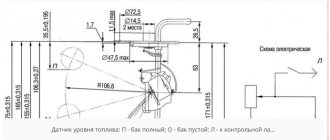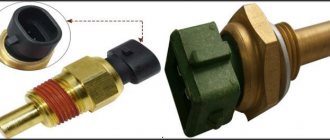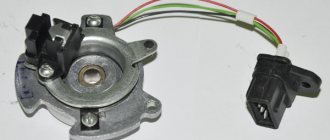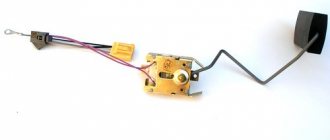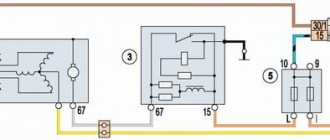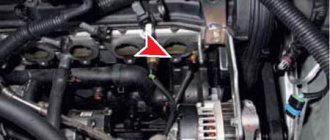28.06.2021
| (Votes: 1, Rating: 5) |
Issues discussed in the material:
- Antifreeze level sensor tasks
- Operating principle of the antifreeze level sensor
- Checking the antifreeze level
- Signs of a malfunctioning antifreeze level sensor
- Replacing the coolant level sensor
- Opinion of car owners on the operation of the antifreeze level sensor
The antifreeze level sensor is not installed on all cars, but it is a very useful monitoring device. If before starting the engine, in a parking lot, it is easy to check the coolant level by lifting the hood and looking at the expansion tank, then this will not work when driving.
Unfortunately, on some brands of cars this sensor often “acts up”, so it is necessary to periodically check its performance. From our material you will learn on what principle the coolant level sensor works, how to find out that it is faulty and replace it if necessary.
Antifreeze level sensor tasks
Even if you do not have much experience in owning a car and the vehicle was purchased not so long ago, you probably know that the engine is the most important part of it. Without an internal combustion engine, a car cannot move. Since the operation of the engine involves flammable substances, a huge amount of thermal energy is released. When fuel burns, heat appears, which has a negative effect on engine elements and leads to their breakdown.
To prevent the internal combustion engine from overheating, closed cooling systems are used; they are made in the form of connected pipes and channels. A special liquid constantly circulates through such a system, it takes thermal energy from the engine and is cooled in the radiator. The antifreeze then enters the engine again, and the cooling cycle is repeated many times while the engine is running.
To prevent pressure from increasing in the cooling system, an expansion tank is installed. As soon as the temperature of the antifreeze increases, the gas formed due to the high pressure is removed through a special hole in the expansion tank.
It is also necessary in order to control the amount of coolant, since the antifreeze level sensor is located in the expansion tank.
Next, let's take a closer look at what this element is, since it performs a very important function. Using this sensor you can monitor the coolant level in the expansion tank.
A reed antifreeze level sensor is most often installed. It is designed as an improved float device with a mechanical switch. This level gauge is budget-friendly, it has a simple design, it rarely fails and provides the ability to monitor changes in the antifreeze level over a wide range.
Reed level gauges are divided into many types. In the simplest of them, the mechanical switch of the float sensor is replaced with a reed switch, this is done to make the device more reliable. However, in most cases, a circuit with several reed switches and a float with magnets is used.
For greater clarity, let’s consider the construction that occurs most often. The sensor is made in the form of a tube; the float moves easily along it. The tube contains reed switches, the number of which can be more or less, depending on the requirements for measurement discreteness.
Different materials are used to make the housing of reed sensors; plastic products are the cheapest. Models with increased strength are more expensive and are made of stainless alloys. To choose the right product, consider the location where the sensor will be located, as well as the requirements for mechanical strength and reliability.
How to change the coolant sensor
1. Open the hood and disconnect the battery terminal.
2. Remove the plug with wires from the external connector of the sensor and unscrew the sensor.
Many manuals suggest draining the coolant. This operation is not necessary since this action does not in any way affect the element replacement process. That is why draining the coolant is impractical and only increases the work time.
3. Install the new sensor and tighten its mounting cover. Connect the plug with wires to its connector.
4. Connect the battery terminal.
This completes the replacement of the coolant level sensor. As you noticed, this is not a complicated procedure at all and is performed without the help of car service specialists.
Operating principle of the antifreeze level sensor
The antifreeze level sensor functions simply, which is why it is reliable.
There is a winding inside the device, it forms an electromagnetic field. There is a float (round magnet) around it; it changes the resistance at the output of the winding. This design is called a “reed switch”. The main control unit monitors the performance of this sensor and changes the data depending on the winding resistance. As a result, it is possible to accurately control the level of antifreeze in the cooling system.
The antifreeze level sensor is located in the expansion tank, most often at the bottom of the container. Therefore, if the coolant exceeds the float threshold, the sensor will signal to the control unit that the level has a positive tolerance.
When the level of antifreeze in the expansion tank is lowered or increased, the magnetic field will change, the spring contacts will touch and the electrical circuit will be closed.
If the antifreeze level decreases, the magnetic field strength of the reed switch will drop, and thanks to the springs, the contacts will take their original position. That is, when the coolant level changes, the contacts close. In an electrical circuit they perform several functions:
- switch;
- close;
- open.
No matter what function is implemented, the circuit is triggered, causing the indicator on the dashboard to light up. On modern cars, the light comes on when the antifreeze level sensor signals that there is insufficient coolant: the contacts open and the lamp circuit turns on. When the contacts touch, the circuit is switched off and the indicator goes off.
When the volume of antifreeze in the tank is insufficient (below the float), the sensor changes resistance. This causes the electronic control unit to signal to the motorist that the coolant level is too low and that coolant needs to be added as soon as possible. This scheme of operation of the antifreeze level sensor is most often used.
When should you think about replacing?
The schedule approved by the manufacturer indicates that the replacement of antifreeze on a VAZ 2109 should be carried out:
- Once every three years, regardless of mileage;
- every 60 thousand km. mileage regardless of operating time.
The expediency of carrying out the operation is relevant when carrying out repair and restoration work with elements of the “cooling” circuit, preparation for which involves draining the coolant. Such work may include replacement:
- heater radiator or cooling system heat exchanger;
- thermostat;
- expansion tank;
- centrifugal pump;
- antifreeze temperature sensor.
Experienced mechanics do not recommend delaying the process of changing antifreeze for a long time. The loss of anti-corrosion and detergent properties, a decrease in the density of the liquid can lead to serious consequences, requiring significantly larger investments than the operation of replacing the coolant.
Before changing the working fluid, the car owner should know what the volume of the Nine’s cooling system is and how much refrigerant it will contain in order to buy the required amount of fluid to complete the task. When changing, the plastic reservoir under the hood will hold about 8.7 liters of antifreeze. If the working substance is not completely drained from the system, then approximately 7-7.5 liters will be poured into it. As for the level control, it is carried out according to the expansion tank marks in the engine compartment. Please note that when the car engine is warm, the fluid volume may be higher. Therefore, before checking, the engine must be turned off and allowed to cool.
Ideally, the refrigerant level should be between two marks - MIN and MAX.
Serber24 user Sani4 in his video clearly demonstrated the procedure for changing antifreeze in a VAZ 2109 car.
Checking the antifreeze level
Experienced drivers always double-check the readings of the antifreeze level sensor. To do this, they inspect the expansion tank. If the engine is cold, the coolant level should be between the maximum and minimum marks. When the engine is running and warm, the coolant level may be slightly higher.
If you are driving a car and the refrigerant level has dropped sharply due to a leak, you will not be able to find out about this by inspecting the expansion tank: it is impossible to stop every 15 minutes and look into the engine compartment.
We recommend
“Antifreeze is leaving the expansion tank: causes and diagnostics” Read more
Therefore, an antifreeze level sensor is needed, the readings of which should be guided by.
If a leak forms and the refrigerant leaks out, or when the antifreeze level drops below the min mark, the sensor signals this. You will see a flashing indicator on the instrument panel. In this case, you should immediately stop driving, park the car and inspect the expansion tank to find out the cause of the breakdown. The antifreeze level sensor allows you to quickly determine that there is a malfunction and prevent the engine from overheating.
It is recommended to check the antifreeze level in the morning when the engine is not running, since the coolant expands. In addition, you should check the electrical contacts on the diagram coming to the sensor. In most cases, damage occurs to the wiring leading to the sensor, which monitors the refrigerant level.
Signs of a malfunctioning antifreeze level sensor
Due to the fact that the car has an antifreeze level sensor, drivers do not need to constantly check the amount of coolant in the expansion tank. However, this device sometimes breaks down, what to do in such a situation?
No one can predict when the sensor will break. If you have a used car, you cannot completely trust the readings of this device.
When the antifreeze level sensor is faulty, the worst thing can happen: the engine will overheat. To prevent such serious damage, monitor the condition of the sensor.
It is important to change the sensor regularly, depending on how actively you use the machine. Replacement should be made before the sensor becomes completely faulty. This way you will protect the internal combustion engine from overheating, preventing major repairs. In addition, you will not need to constantly inspect the expansion tank.
You can understand that the reed switch has failed in a situation where the refrigerant level is below the required level, but the indicator does not light up. In rare situations, this happens because the light bulb has burned out or the wiring has failed, but the sensor itself is working. But when the listed items are in order, it indicates that it is time to replace the reed switch.
Temperature sensor VAZ 2109 injector where is it located
Actually, one day I see the coolant needle creeping into the red zone.
The fan turned on at 120, the computer showed 105 degrees. Without delay, I replaced 2 sensors 1. DTOZH 2. Temperature sensor The first one is on the thermostat, easy to unscrew and install, the other is on the head under the thermostat. In both cases, antifreeze will flow, the main thing is to have time to tighten it. To do this, you need to remove the air filter housing.
As a result, after installation we have an average temperature of 80-81. The arrow is in the middle and shows 80 degrees. You will have to disassemble the shield to set the coolant arrow to the correct position. Or is there something else you can think of?
Each car engine is equipped with a device for measuring the temperature of the power unit. This component allows the driver to detect overheating in time and eliminate this problem. What is the fan switch on sensor on a VAZ 2109 with a carburetor engine, what is its structure and how to replace it - read on.
Replacing the coolant level sensor
In most cases, it will not be possible to repair or restore the antifreeze level sensor. The fact is that during the production of this device the body is made airtight, it is cast in special molds. It is impossible to disassemble and reassemble such an element. However, the price of a new part is small, so it is easier not to repair the sensor, but simply replace it.
When you do not have the opportunity to visit a service station, and the antifreeze level sensor is broken, you can replace it yourself, even if you have no experience in carrying out this type of work. The algorithm of actions is as follows:
- remove coolant from the expansion tank;
- remove the air filter;
- We take the sensor out of the rubber cover.
Then, instead of it, we install a working reed switch, focusing on the markings located on the body of the sealed switch. To do this job, you will need a 21 wrench; it is suitable for almost all models of sensors.
Diagnostics and repair
Checking the functionality of the sensor is quite simple. In most cases, the system immediately notifies you if it malfunctions using a light signal on the dashboard. Typical symptoms of a malfunctioning temperature and coolant level sensor:
- Atypical position of the mechanical indicator or certain codes during automatic vehicle control;
- Interruptions in engine operation at idle speed;
- Inability to start the engine;
- The radiator lights up during operation;
- Loud, unusual engine sounds during operation.
Opinion of car owners on the operation of the antifreeze level sensor
1. I cleaned the contact, but nothing changed.
“I rode 25 kilometers, and the message “Coolant Level Low” popped up on the dashboard, meaning that the refrigerant level was insufficient. The indicator also started to light up, indicating that the motor was overheating. I immediately parked the car, checked the expansion tank, there was enough antifreeze. I continued driving, and throughout the entire trip the inscription disappeared and then reappeared.
The next day I added coolant to the maximum level. I drove 25 kilometers again, and the situation repeated itself as yesterday: the indicators are flashing, but there is enough coolant in the expansion tank.
I removed the sensor, cleaned the contact, but nothing changed. I bought a new one and installed it. Now everything is fine, no errors are displayed. I want to repair the old sensor, maybe it will work out. As for the instructions and blinking, they believe that when the indicator blinks, the coolant level is insufficient. When the motor overheats, the indicator lights up along with the “stop”, I didn’t notice what inscription appears when it overheats. My car is from 2010."
2. The electronic control unit displays errors.
“The electric pump is called the “cooling system pump”, it is located so that it can be easily inspected: at the bottom on the left side of the edge of the motor, I hope I explained it clearly.
Even after replacing the electric pump, the situation remained the same. I went to the service station again, the mechanic installed a new antifreeze level sensor. I'm currently driving the car in test mode. What they said at the car service: when the fault codes are read, an error is indicated for the electric cooling pump, so they decided to replace it. When the antifreeze level sensor fails, the failure appears on the indicator, but it is not indicated.
That is, if no errors were found when reading the codes, the mechanic would change the level sensor. But since the cooling system pump was faulty, they decided that the reason was this part and replaced it. Now everything works without problems. I believe that the malfunction occurred due to the sensor, but the electric pump of the cooling system was also added to this breakdown.”
Operating principle and measurement
Basically, the car uses float fluid level sensors. When the coolant is at normal levels, the magnetic ring acts on the reed switch (this is a magnetic switch equipped with contacts). At this moment, the sensor contacts open, the resistance is within 3300 Ohms. When the washer fluid level drops, the float together with the magnet drops to the level of the reed switch, and it closes the sensor contacts. At this moment, a signal is heard on the dashboard, the contacts of which are closed to ground.
Photo – sensor readings
In this case, conductometric sensors and other coolant measuring devices are polled by the control unit every second. If the meter malfunctions or there is insufficient resistance, there is not enough data to determine the level.
Photo – fuel level sensor

